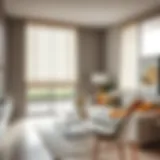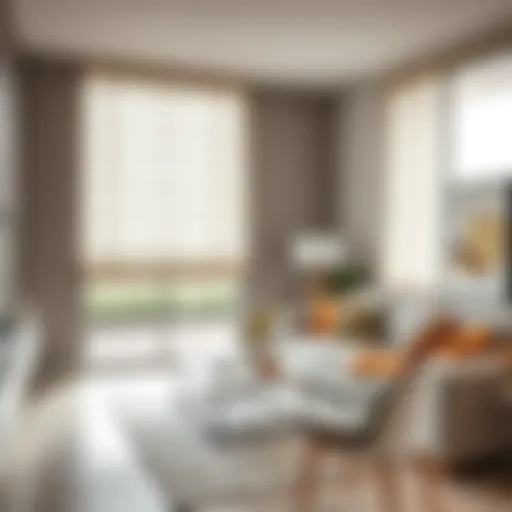Discovering Small Flower Plants for Indoor Spaces
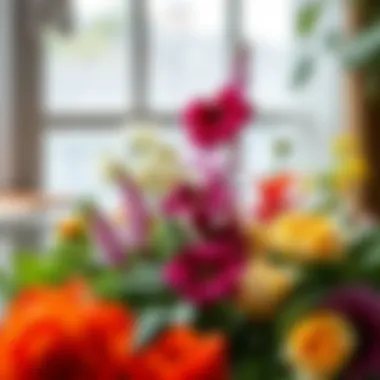
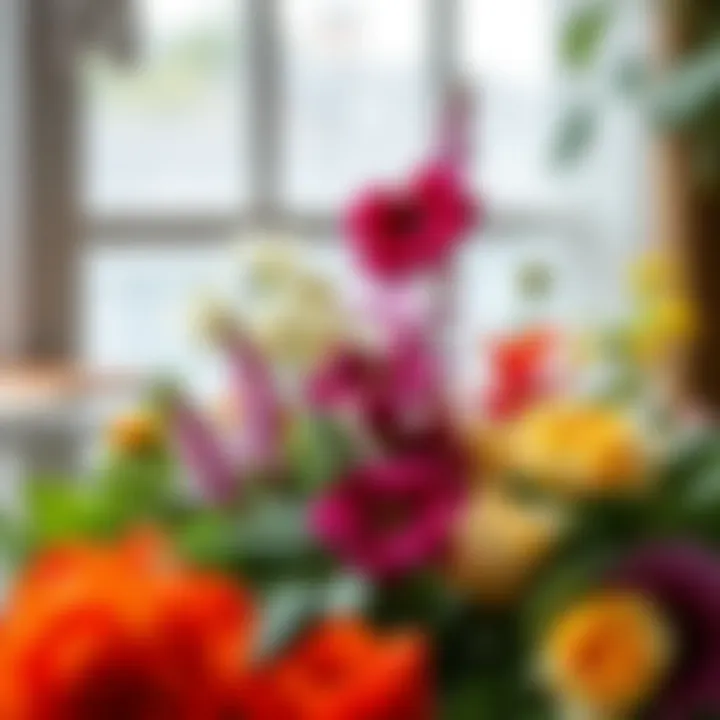
Intro
When it comes to enhancing indoor environments, small flower plants can make a world of difference. They not only infuse color and vibrancy into living spaces but also come with a myriad of benefits ranging from cleaner air to improved mood. Picking the right flower plants might seem daunting at first—after all, there is an overabundance of choices available worldwide. However, understanding the particulars concerning every type can make the decision process simpler and even enjoyable. This article aims to guide you through the selection of small flower plants tailored for indoor spaces, combining aesthetic appeal with practicality.
We will delve into the various types of plants that flourish indoors, examining their care needs, suitable placements, and the positive impact they can have on decor. In addition, we will explore design ideas that make the most of these botanical treasures, creating a harmonious balance between nature and interior design. By the end of this exploration, your journey toward making informed home decor choices regarding indoor plants will feel much clearer.
Preface to Small Flower Plants for Indoors
Bringing small flower plants into indoor spaces can truly make a world of difference. It’s a topic that deserves close attention for various reasons. Firstly, these plants do not merely sit in a pot—they breathe life into a room, acting as vibrant focal points that spark joy and tranquility. Many homeowners, decorators, and realtors understand that well-placed plants can elevate a space’s ambiance, contributing to both aesthetic beauty and a welcoming atmosphere.
Imagine stepping into a cozy living room. A well-cared-for African Violet or a cluster of cheerful Pansies can draw the eye and make the space feel instantly more inviting. The importance of small flower plants indoors extends beyond just visual appeal. In a world where many of us are confined to living and working inside, these plants serve as essential tools for improving air quality. They help filter toxins and can restore a sense of nature amidst urban settings.
Furthermore, introducing such botanical elements can offer psychological benefits. Studies suggest that having plants indoors can decrease stress levels and enhance mood. A flowering plant can be a gentle reminder of the beauty outside, fostering a sense of wellbeing that other décor items might not achieve.
It’s also important to consider the practicality of caretaking. Many small flower plants require minimal space and can be quite low maintenance, which makes them accessible for even the busiest of lifestyles. With the right selection, anyone can enjoy the beauty and benefits of indoor flowers without the burdensome commitment often associated with gardening.
In sum, this exploration of small flower plants for indoor spaces highlights not just decor options but also underscores their multifaceted role in enhancing our quality of life indoors. Choosing the right flowers can transform any room into a refreshing oasis of color and calm. As we delve further into considerations like light conditions, plant selection, and care guidelines, you will find plentiful insights that can help you make informed decisions to beautify your home.
Advantages of Small Flower Plants Indoors
When one speaks of houseplants, the immediate image that often comes to mind is a simple leafy green. However, small flower plants add a whole new dimension to indoor greenery. The benefits of having these sporadic bursts of color are manifold, making them an integral part of indoor decor. Not only do they elevate the aesthetic of a space, but they also provide tangible advantages that can enhance the quality of life for the inhabitants. From refreshing the air in your home to positively impacting one's mood, these tiny floral wonders pack quite a punch.
Aesthetic Appeal
The visual charm of small flower plants is undeniable. Picture a room filled with greenery, and then imagine it further adorned with little splashes of color from blooming flowers; it's as if nature brings its canvas into your home. Small flower plants like African Violets or Miniature Roses don’t just stand there; they sing melodies of color, enhancing the ambience of any room significantly. They can serve as artistic pieces, capable of complementing various design styles—from minimalistic moderns to cozy traditional settings.
When placed correctly, they can draw attention to specific areas, creating focal points that invite conversation. Whether set on a windowsill, a coffee table, or in clusters on a shelf, their aesthetic value cannot be overstated. As one might say, a little color can go a long way in brightening up a space and the spirits of those within it.
Air Quality Improvement
In a world where indoor air pollution is a growing concern, small flower plants can come to the rescue, so to speak. Plants like Peace Lilies and Spider Plants are notable for their air-purifying properties. Research has shown that certain houseplants can absorb harmful toxins and increase oxygen levels.
According to studies conducted by NASA, common indoor pollutants such as formaldehyde can be significantly reduced through strategic placement of plants. In effect, cultivating small flower plants is not just a decorative endeavor; it's a step toward a healthier living environment. Just as they add color to our walls, these plants cleanse and refresh the very air we breathe.
"Bringing plants indoors does more than beautify our surroundings; it actively makes our lives healthier, enhancing air quality."
Psychological Benefits
There’s a certain therapeutic quality to being around plants, especially those that bloom. Studies in environmental psychology suggest that the presence of plants can substantially reduce stress and anxiety levels. Imagine returning home after a long day, only to be greeted by the gentle blooms of a Primrose or the cheerful faces of Pansies; it can feel like dark clouds parting for a bit of sunshine.
Moreover, engaging with these plants—tending to their watering, pruning, and feeding—provides a constructive outlet, allowing individuals to unwind and focus their minds away from daily worries. The simple act of nurturing living beings fosters a sense of responsibility and connection to nature, which can enhance one’s mood and overall outlook on life.
In summary, small flower plants in indoor spaces are much more than mere decorations. They offer aesthetic joy as well as practical benefits, contributing profoundly to air quality and psychological well-being. By incorporating these beautiful plants into your home, you make a choice that benefits not just the eyes, but the air we breathe and the minds we inhabit.
Selecting the Right Small Flower Plants
When it comes to enhancing your indoor space with small flower plants, making the right selection is crucial. The array of choices available can leave one feeling a bit overwhelmed, but understanding various aspects can make the task clearer.
Choosing the right plants is not only about aesthetics; it's about ensuring that both you and the plants thrive together. This section uncovers essential considerations that will guide homeowners, decorators, and even novice plant enthusiasts in making informed decisions.
Considerations for Light Conditions
Plants are living beings that respond to their environment, with light being a primary factor. Each plant species harbors its own preferences, ranging from high-light lovers like orchids to shade seekers such as African violets.
To choose wisely, assess the light conditions in the areas where you plan to place your plants. Here are some factors to consider:
- Natural Light Availability: Observe how much light filters through your windows. Rooms facing north receive the least light, while south-facing windows tend to bathe plants in sunlight for the longest hours.
- Artificial Lighting: If your space has limited natural light, consider using grow lights. They mimic sunlight and can extend the plant variety you can successfully cultivate.
- Duration of Light Exposure: Plants also respond to how long they get light. Some prefer a few hours of bright light, while others can flourish in more subdued situations.
Above all, before selecting any plant, ensure that its light requirements match those of your indoor environment. Once that's aligned, you can cultivate not just a garden, but a sanctuary.
Assessing Space and Size
We often underestimate how much space a plant actually needs. Selecting a small flower plant is more than just picking a pretty face; it's about understanding its growth potential. Some plants may start tiny but grow quickly, while others remain more petite with consistent care.
Here’s what to keep in mind:
- Available Surface Area: Consider the space where the plants will live. Will they sit atop tables, on windowsills, or in hanging baskets? Measure the area to understand how many plants you can realistically have without overcrowding.
- Growth Patterns: Research how large specific plants can get. Some mini roses may flourish into larger blooms, requiring more space than anticipated. Packaged information usually provides detail on the expected dimensions.
- Accessibility for Care: Ensure that the plants are placed in locations you can easily reach for watering, pruning, or adjusting as needed. A beautiful plant isn’t worth much if it becomes too much of a hassle to maintain.
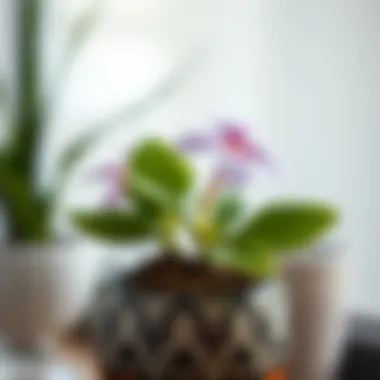
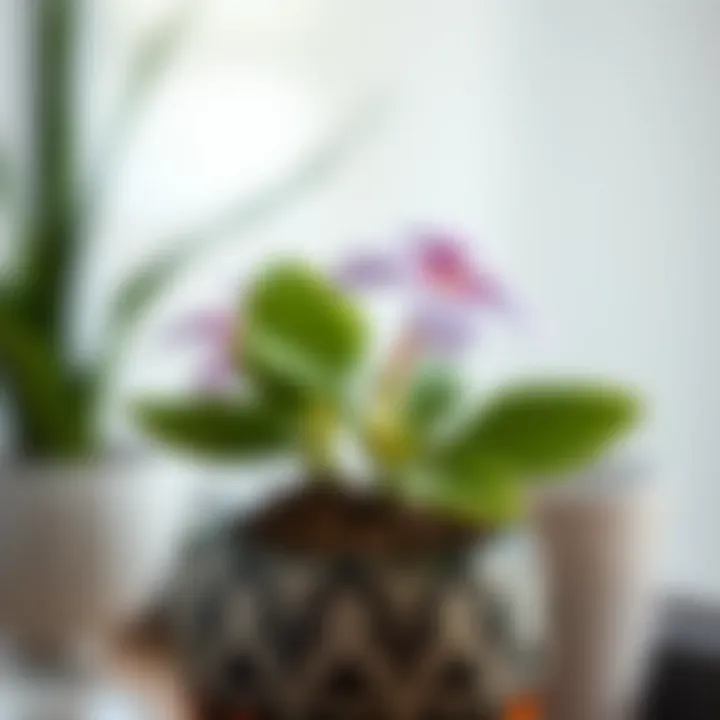
By understanding your space and the plants’ needs, you can maintain not only healthful greenery but also appealing arrangements that don’t clash with your home’s flow.
Personal Aesthetic Preferences
Ultimately, what's the point of having plants indoors if they don’t resonate with your personal style? Choosing small flower plants should reflect your tastes and feelings. After all, these lively companions should evoke joy and warmth in your indoor spaces.
Here’s a few points to ponder as you explore your preferences:
- Color Schemes: Think about the colors existing in your decor. Do you prefer soft, pastel hues or bold, vibrant shades? Certain small flower plants like pansies come in a multitude of colors, allowing for varied choices.
- Plant Forms and Foliage: Not all beauty comes from flowers alone. The shapes, textures, and even colors of the foliage can add definition. Consider plants like miniature orchids, which offer elaborate blooms, contrasted by the lush foliage of other plants.
- Cultural significances and memories: Sometimes, specific plants evoke personal stories or childhood memories. If there’s a flower that reminds you of a special place, incorporating it into your home can create emotional connections.
When small flower plants are aligned with your aesthetic, they serve not merely as decorations, but as pieces of life that tell your story.
"In a world full of trends, I want to remain a classic." – Ilaria Urbinati
Selecting the right small flower plants becomes an art when you consider these vital aspects. By focusing on light, space, and personal style, each homeowner can curate a collection that resonates on multiple levels, creating functional and eloquent decor in their indoor spaces.
Popular Varieties of Small Flower Plants for Indoors
Exploring small flower plants for indoor environments is crucial, as these varieties not only elevate the aesthetic appeal of our homes but also inject a pop of personality into spaces often muted by bland decor. When selecting the right plants, one should consider their individual characteristics, care requirements, and overall contribution to indoor ambiance. Below, we dive into some popular small flower plants, shedding light on their unique attributes and why they might be a perfect fit for your indoor sanctuary.
African Violets
Few indoor plants encapsulate charm quite like the African violet. Characterized by their vibrant blooms that can range from lavender to deep purple, these flowers add a touch of elegance. They thrive well in low light, making them a stalwart choice for homes that may not boast an abundance of natural sunlight. One should note, however, that African violets prefer to be kept in a warm environment and should be watered from the bottom to avoid leaf spotting. The rewarding aspect of these plants is their ability to blossom year-round with the right care, fluttering their delicate petals and reminding us of spring no matter the season.
Miniature Roses
Miniature roses make a bold statement in a compact size. Typically blooming in shades of pink, yellow, and white, they can enhance any room with their rich hues and delightful fragrance. It's essential to provide them with bright light and they benefit greatly from regular pruning to encourage new growth. This vibrant plant not only beautifies spaces but also plays well with other decor elements, creating a cohesive them throughout your interior. Keep an eye on moisture levels, as these roses can be a bit finicky when it comes to watering.
Orchids
When it comes to exotic allure, orchids are unmatched. Their sprawling varieties showcase a spectrum of colors and shapes, making them highly desirable for any indoor collection. While they might seem high maintenance, their care is manageable for most home gardeners. Orchids enjoy indirect sunlight and consistent humidity, so checking their potting medium for dryness is key. This singular beauty captivates attention and adds sophistication to your living area, reminding onlookers that elegance can grow in unexpected places.
Pansies
Pansies are often thought of as an outdoor staple, yet when potted inside, they can completely transform a space with their bold colors and whimsical charm. They are relatively easy to care for, flourishing in moderate light and cooler temperatures. Pansies tend to enjoy being placed near windows where they can receive a good amount of indirect sunlight. This makes them a perfect candidate for brightly colored arrangements or standalone displays that can lift spirits in any corner of your home.
Primroses
Primroses burst into life with their vibrant blooms and captivating fragrances. They bring a pleasant scent and a splash of color to any indoor setting. These plants favor cooler temperatures, so positioning them away from direct heat is important. It's vital to ensure their soil remains moist but not soggy; overwatering can quickly become a problem. As they bloom in various shades, they not only serve as cheerful accents but also offer the potential for delightful seasonal displays through winter and spring alike.
In summary, the diversity of small flower plants available for indoor spaces is not just a boon for home decor but serves as a reflection of personal taste. Each variety has its charm and particular care requirements, making it essential for homeowners and designers to consider all aspects when choosing the right plants. Integrating these flowers into your indoor spaces promises not only aesthetic refinement but also brings life and vitality into the home, enhancing the overall atmosphere.
Basic Care Guidelines for Indoor Flower Plants
Taking care of small flower plants indoors is more than just a hobby; it’s a passion that nurtures both the plant and the individuals who grace their presence. Proper care ensures that these plants not only survive but also thrive, bringing vibrancy and life to any indoor environment. Understanding the basic care guidelines can arm homeowners and enthusiasts alike with the knowledge needed to make informed choices, keeping their plants healthy while enhancing the aesthetics of their living space.
Watering Techniques
Watering is one of the cornerstones of proper plant care. But, it's not as straightforward as just pouring a bit of water into the pot. The amount of water and the frequency can make or break a plant's health. Here are some useful insights:
- Check the Soil Moisture: Instead of following a strict schedule, check the soil's moisture level. Stick your finger about an inch deep; if it's dry, it’s time to water.
- Use Room Temperature Water: Cold water can shock the roots. Let water sit out for a while before using it. This helps in maintaining a consistent temperature.
- Watering Methods: Some prefer bottom watering, where pots sit in water for a time, allowing roots to absorb it as needed. Others find the top-down method practical. Just be sure to avoid getting excess water on the leaves.
Proper watering techniques not only lead to healthier plants but also help in avoiding issues like root rot, which can be a major setback.
Fertilization Strategies
Fertilizing your indoor plants can sound a bit daunting, but it's an essential part of maintaining plant health. Plants draw nutrients from the soil, and as this soil is used for longer, it can become depleted.
- Choose the Right Fertilizer: Make sure your fertilizer suits your specific plant types. For example, African Violets thrive with a balanced, water-soluble fertilizer.
- Know the Season: During the growing season, typically spring and summer, plants benefit from regular feeding. In contrast, during the fall and winter months, it’s wise to cut back.
- Dilute When Needed: It’s better to err on the side of caution. Many beginners make the fatal mistake of over-fertilizing. Diluted solutions often work wonders.
Fertilization isn't just a routine task; it's a way to support your plant's growth and flowering, allowing it to express its full potential and bring joy into your home.
Temperature and Humidity Control
Creating the right environment means paying careful attention to temperature and humidity levels. Many indoor flower plants aren’t particularly fond of extreme conditions, and a little adjustment can go a long way.
- Stick to the Sweet Spot: Most indoor flower plants prefer temperatures between 65°F to 75°F (18°C to 24°C) during the day and slightly cooler at night.
- Monitor Humidity: Some plants love humidity, while others can be finicky. If your home feels dry, especially in winter, consider adding a humidifier or using pebble trays filled with water beneath your pots.
- Keep Away from Drafts: Position your plants away from drafty windows or heating vents. Sudden changes can stress plants, leading to dropped leaves or stunted growth.
By maintaining optimal temperature and humidity levels, you ensure that your flowering indoor companions remain vibrant and visually appealing.


"The difference between a plant that thrives and one that withers often lies in the details of care—not just for the plant, but for the environment they’re in."
When it comes to indoor gardening, the small steps you take in watering, fertilization, and environmental adjustments can make a huge difference in creating an inviting and beautiful indoor oasis.
Potting and Display Ideas
When it comes to small flower plants in indoor spaces, the choice of pots and the strategies for displaying them can make a world of difference. The right pot ensures the plant thrives, while the display enhances the overall aesthetic of your home. This section will dive into how you can elevate your indoor garden experience through thoughtful potting and creative displays.
Choosing the Right Containers
Selecting suitable containers for your plants transcends mere practicality. Think of it as tailoring your plants’ wardrobe; the right pot can be both functional and stylish. You should consider the following criteria:
- Size and Drainage: Ensure that the pot is appropriately sized—the plant should have enough space to grow, but not so much that it feels lost. Drainage holes are crucial; standing water can lead to root rot.
- Material Considerations: Materials like terracotta offer breathability, while ceramic can be a stylish option. Plastic pots are lightweight and often come with good drainage. Choose what aligns with your aesthetic.
- Color Coordination: The pot's color can significantly influence the overall vibe of your indoor space. Bright, lively colors can add cheer, while neutral tones often create a more serene atmosphere.
Choosing a pot is not just about the plant's needs—it’s about how that pot will fit into your decor.
Arranging Plants for Visual Impact
Arranging your small flower plants into visually appealing displays can transform your living space altogether. Here are some techniques to consider:
- Grouping by Height: Place taller plants in the back of a space, gradually moving down to smaller plants in the front. This creates depth and invites the eye to travel across your display.
- Mixing Textures: Combining plants with different leaf shapes and textures creates an engaging contrast. For instance, pairing smooth-leaved orchids with the ruffled leaves of a primrose can add intrigue.
- Symmetry vs. Asymmetry: Symmetrical arrangements can bring a sense of order, while asymmetrical designs can impart a more dynamic feel. Make sure you balance the visual weight of your arrangements either way.
Utilizing principles of design not only beautifies your space but also keeps the plants healthy by ensuring they have adequate light and airflow.
Utilizing Vertical Space
For those working with limited floor areas, vertical space utilization becomes a lifesaver. Here are some strategies to maximize your vertical gardening:
- Wall Planters: Installing wall-mounted planters turns any wall into a green canvas. This is an excellent way to add foliage where floor space is scarce. Many wall planters come in multiple tiers, allowing for a lovely layered look.
- Hanging Planters: Use macramé or metal hangers to suspend plants from the ceiling. This not only saves space but adds a unique touch to your decor. Ensure that the plants chosen for hanging can tolerate being out of easy reach.
- Shelving Units: Create varying levels by using shelving units. Place different plants on different shelves to draw the eye upward, making the space feel larger.
Maximizing vertical space is not just a solution for confined areas; it also provides drama and depth to your indoor gardens, allowing more diverse plant life to flourish in your home.
Placement and Environment Considerations
Placement and environment are two sides of the same coin when it comes to cultivating small flower plants indoors. A seemingly trivial detail, the right positioning can make a world of difference for the health and growth of your plants, allowing them to thrive and contribute meaningfully to your living space. Understanding the natural habits of plants, along with the unique qualities of your indoor environment, is essential for creating a successful indoor garden.
Benefits of Proper Placement
Having plants that flourish in their surroundings not only enhances the beauty of your home but also boosts the well-being of everyone living there. Bright, healthy plants can lift a room's aesthetic while purifying the air. Additionally, strategically placing plants can act as a natural partition, softening the rigid edges typical of home interiors.
Optimal Locations for Natural Light
When it comes to light, not all plants are created equal. Certain species have specific light requirements vital for their growth. For instance, while orchids often enjoy bright indirect light, African violets prefer to bask in moderate light.
- Assessing Light Availability
Before choosing a spot for your plants, consider the amount of sunlight that each area in your home receives throughout the day. Windows that face south usually provide the most light, so situating your plants there would likely be beneficial. However, if you find that some rooms receive only sporadic sunshine, look for opportunities to use grow lights. - Adjusting for Seasons
Seasons can drastically affect the amount of natural light available. It's not as simple as putting plants by the window and calling it a day; some plants might need to be relocated with the changing seasons to maintain their health. Noting these seasonal variations can make all the difference in your plant care routines.
"Plants that get the right amount of light can shine in their full glory, while those left in the shadows may wither away."
Avoiding Drafts and Extreme Temperatures
Indoor spaces often come with their own set of microclimates created by air conditioning, heating, and even window drafts. Being mindful of these environmental factors is key to creating a happy home for your plants.
- Drafts
Plants are often sensitive to sudden changes in temperature, particularly drafts from windows and doors. Ensuring that your plants are not in the direct line of cold drafts is crucial. A sudden chill can stress plants, causing their leaves to drop or worse, inviting pests and diseases. - Temperature Regulation
Take into consideration the temperature settings in your home. Many small flower plants prefer a consistent temperature range, typically between 65°F to 75°F (18°C to 24°C). Be cautious of placing them too close to heaters where they may get scorched or in nooks with fluctuating temperatures.
By understanding how placement and environmental factors play into your plant care, you're better equipped to create a thriving indoor oasis. Every facet, from light to temperature, contributes to the overall vitality and aesthetic of your indoor flower garden.
Common Issues and Troubleshooting
Common issues with indoor flower plants can turn the joy of nurturing greenery into a rather daunting task. Even with the right intentions, conditions often arise that can challenge a plant's growth. This section provides valuable insights into the most frequently faced issues and offers practical solutions. By understanding potential problems such as pests and diseases, indoor gardeners can create a more thriving environment for their plants. Having knowledge of these challenges is crucial, as it not only helps in conserving your beloved plants but also protects your overall indoor aesthetics.
Pest Management
Pests are the uninvited guests in your indoor garden, and their presence not only affects your plants' health but can also harm your space's ambiance. There are various types of pests that can target indoor plants, such as aphids, spider mites, and whiteflies. These sap-sucking creatures can cause wilting and leaf yellowing, leading to poorer air quality and an unsightly appearance.
To keep these nuisances at bay, consider implementing the following strategies:
- Regular Inspection: Examine your plants regularly. Check the undersides of leaves, where many pests like to hide. Early detection is half the battle.
- Natural Predators: Introduce beneficial insects like ladybugs, which feast on pest populations, providing a natural form of protection.
- Homemade Remedies: Create mixtures with dish soap and water or neem oil spray to deter pests. Just be sure to test on a small area first to ensure your plants can handle the treatment.
- Hygiene: Keep the gardening area clean. Wipe down leaves and eliminate debris, where pests might thrive.
In doing all these, you cultivate not just the plants but the environment they grow in, warding off invading bugs and enhancing your indoor spacies.


Identifying Plant Diseases
Despite your best care, infections can target even the healthiest of plants. Recognizing the signs of common plant diseases is critical for a quick recovery. Symptoms can vary widely, from unusual spotting on leaves to stunted growth or even plant collapse.
Here's how to troubleshoot potential diseases effectively:
- Leaf Discoloration: Yellowing might signal nutrient deficiencies or overwatering, whereas dark spots suggest fungal infections.
- Wilting: If your plant wilts despite adequate water, root rot could be lurking beneath the surface.
- Mold and Mildew: White powdery layers on leaves can indicate a fungal infection. Good air circulation and lower humidity can combat this issue.
- Remove Affected Parts: If you see a part of the plant that is affected, it's best to prune those areas right away to stop the spread.
- Quarantine New Additions: When bringing new plants home, keep them separate from your existing collection for a couple of weeks. Inspect these newcomers for signs of disease before introducing them to their new home.
By honing your ability to spot problems early, you'll likely save your plants from unwelcome demise and keep your indoor space flourishing, making it a haven you can enjoy for years to come.
Remember: "An ounce of prevention is worth a pound of cure." Regular attention to your plants can help fend off many of these issues before they arise.
Sustainable Practices in Indoor Gardening
Sustainable practices in indoor gardening are crucial not just for the plants themselves, but also for the health of our planet and our homes. By adopting eco-friendly methods, homeowners and designers alike can significantly reduce their environmental impact while maintaining vibrant, flourishing indoor plants. These activities promote responsible gardening, ensuring that our green spaces thrive without compromising the planet's resources.
The adoption of sustainable practices can lead to several positive outcomes, including:
- Reduction in chemical usage: Utilizing organic pest control methods minimizes harmful chemical residues in your indoor environment.
- Lower carbon footprint: By opting for local and organic products, you're likely to reduce transportation emissions associated with gardening supplies.
- Biodiversity promotion: Sustainable gardening encourages diverse plant growth, which benefits the ecosystem as a whole.
- Water conservation: Implementing water-efficient practices helps in managing resources effectively, especially in areas facing water shortages.
Thus, sustainable indoor gardening is not merely a trend; it is an essential step toward harmonious living with nature.
Organic Pest Control Methods
Managing pests organically is a hallmark of sustainable gardening. Instead of resorting to synthetic pesticides that can pose health risks to both humans and pets, consider several alternatives that effectively keep your plants healthy:
- Neem oil: Extracted from the seeds of the neem tree, this natural insecticide disrupts the life cycle of pests while being safe for beneficial insects.
- Diatomaceous earth: This powdery substance is composed of fossilized algae and can be sprinkled on the soil or affected plants to deter crawling insects.
- Companion planting: Certain plant pairings can repel pests naturally. For instance, marigolds alongside tomatoes can deter nematodes.
Employing these methods helps maintain a balanced ecosystem in your indoor garden, ensuring that pests are kept in check without the use of harsh chemicals.
Eco-Friendly Fertilizers
Fertilizing your indoor plants with eco-friendly options is another crucial aspect of sustainable gardening. Chemical fertilizers might provide quick results, but they often harm the soil and surrounding environment over time. Here are some noteworthy alternatives:
- Compost: Homemade compost enriches the soil with nutrients, improves drainage, and enhances microbial activity.
- Worm castings: This organic material, produced by earthworms, is nutrient-rich and promotes healthy plant growth.
- Liquid seaweed: A natural option that provides essential elements for healthy plant development while improving disease resistance.
By using these eco-friendly fertilizers, you're not just nourishing your plants; you're also contributing to a healthier indoor environment. Through sustainable practices like organic pest control and the use of eco-friendly fertilizers, you can cultivate a thriving indoor garden while prioritizing the health of our planet.
The Role of Indoor Flower Plants in Home Decor
Integrating small flower plants into indoor spaces is more than just a nod to aesthetics; it's about creating environments that resonate with warmth, vitality, and an undeniable sense of style. The incorporation of these flowering beauties can redefine a room, injecting life into corners that might otherwise feel bare or uninspired. For homeowners and interior designers alike, the strategic use of plants is an essential aspect of modern decor. It isn’t just about dressing up a space; it's about enriching the atmosphere.
Enhancing Interior Design
Small flower plants have the remarkable ability to enhance overall interior design. Think about it: a vibrant pot of Miniature Roses sitting on a coffee table can draw the eye and serve as a conversation starter. These plants can bridge the gap between furniture pieces, creating a flow that invites relaxation and engagement. When selected thoughtfully, they incorporate texture, shape, and color that harmonize with existing decor.
One effective way to boost design is through the deliberate pairing of plants with furniture styles. If one has a minimalist, contemporary setup, choosing sleek pots with symmetrical plants like Orchids will provide balance. Conversely, a cozy, bohemian space might call for a whimsically colorful arrangement of Primroses or Pansies. A successful plant arrangement can create a focal point or soft spots for the eye to rest upon, enhancing the room's overall aesthetic.
"A well-placed plant not only brightens a room but it can also transform the very vibe of a space."
In addition, plants help to create a more inviting atmosphere. Natural elements like greenery can soften hard edges found in many modern designs. This contrast is essential when curating a space that feels both stylish and comfortable. It’s about finding balance, and small flower plants can often bridge the gap better than any piece of furniture can.
Complementing Color Schemes
Color is a fundamental principle in design, and small flower plants offer a unique way to complement and enhance existing color schemes. The vibrant hues of flowers, such as the rich purples of African Violets or the warm yellows of Daffodils, can be integrated into established palettes. Homeowners can choose plants whose colors echo or accentuate wall colors or nearby decor items, creating a cohesive look that appears effortlessly curated.
When a room features earthy tones, the contrasting colors of flowering plants can inject energy and depth. For instance, a deep green foliage of a plant may serve as a great backdrop to bright, conflicting flower colors. Alternatively, if one aims for a tranquil atmosphere, soft pastels from plants like mini Roses could harmonize beautifully with light-toned furnishings to promote calmness.
In addition, the idea of seasonal decor can also come into play. For those who enjoy rotating their decor throughout the year, plants become essential tools. For instance, bright creamy daisies can herald the arrival of spring, while the bold reds of Christmas Cacti might take center stage during the festive season. Changing out plants not only keeps decor fresh but also allows for continual engagement with one’s living space.
Lastly, it’s valuable to consider the use of textured pots and containers to complement the look of plants. A rough ceramic pot paired with glossy, colorful flowers creates a beautiful contrast that can add depth to the overall design scheme. Thus, the color and texture interaction among plants, their pots, and other decor elements plays a crucial role in indoor decoration; it’s an ongoing dance that is ripe for exploration.
Closure
In sum, the exploration into small flower plants for indoor spaces unveils a myriad of benefits and practical considerations that can significantly enhance the ambiance of one's home or office. Small flower plants are not just charming additions; they serve a deeper purpose in transforming indoor environments into vibrant and inviting spaces. These plants, ranging from the rich hues of African violets to the delicate beauty of miniature roses, bring a touch of nature indoors, creating a sense of harmony amidst the bustling pace of daily life.
The Benefits of Indoor Small Flower Plants
Among the many advantages, small flower plants contribute to improved airflow and aesthetics. They act as natural air purifiers, absorbing toxins and releasing oxygen which is essential for maintaining a healthy indoor atmosphere. The visual appeal they offer cannot be overstated. The right plants can complement any design scheme, becoming focal points or subtle enhancements to existing decor. The colors and textures provide dimension and interest that elevate the overall style of the space.
Key Considerations
When deciding on the right small flower plants for a particular environment, homeowners, decorators, and interior designers must consider several factors. Think about light conditions—a well-lit space allows a broader range of plant choices while dimmer areas might require specific low-light tolerant options. Additionally, taking stock of the available space is crucial. Not all plants are created equal; certain varieties are compact, making them ideal for snug setups, while others may need a bit more room to flourish.
Reflecting Personal Style
Ultimately, the selection process should resonate with personal aesthetic preferences. Plants have personalities of their own and can reflect the owner's style and taste. A well-curated plant collection can speak volumes about the individual’s taste, setting the mood and tone of the space.
“The greenery in your home could very well be the heart that pumps life into your living environment.”
Small flower plants do not merely adorn spaces; they influence emotional well-being, sparking joy and instilling a sense of tranquility. As explored throughout this article, their successful incorporation into indoor decor necessitates careful thought and planning but rewards the effort with sheer beauty and serenity.
